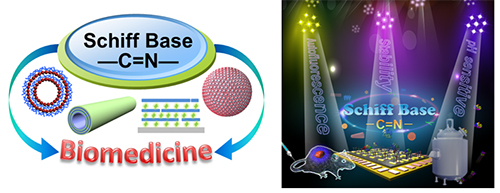


Schiff Base bond (imine bond) is a kind of dynamic covalent bond. Compared to electrostatic interaction, hydrogen bond and other non-covalent bonds, Schiff base bond endows the assembly with higher stability, allowing it to withstand harsh conditions. Compared to conventional covalent bond, Schiff base reaction proceeds under ambient conditions without activation and involves only water as by-product that contamination of the assemblies by impurities was avoided, which is essential for fabrication of certain sensors and reactors. Besides, the formation of Schiff base bond enables the assemblies with autofluorescence and pH-sensitivity. All these merits make Schiff base interactions attractive in multilayer assembly with the LbL method, especially for those applied in biomedicine.
Professor Li Junbai’s group at the CAS Key Lab of Colloid, Interface and Chemical Thermodynamics of the Institute of Chemistry, Chinese Academy of Sciences has made a series of progress on molecular assembly based on Schiff base interactions. (Adv. Funct. Mater. 2012, 22, 1446; ACS Nano 2012, 6, 6897; Chem. Commun. 2011, 47, 1175; Nanoscale 2015, 7, 82; Biomaterials 2009, 30, 2799; Biomacromolecules 2009, 10, 1212; Adv. Mater. 2008, 20, 601).
Recently, this group reported these research findings on journal of American Chemical Society: Chemical Reviews (2015, 115, 1597-1621) entitled as “Molecular Assembly of Schiff Base Interactions: Construction and Application”. This review article covered the most recent research work in the field of molecular assembly based on Schiff base interactions and their applications in biomedicine.